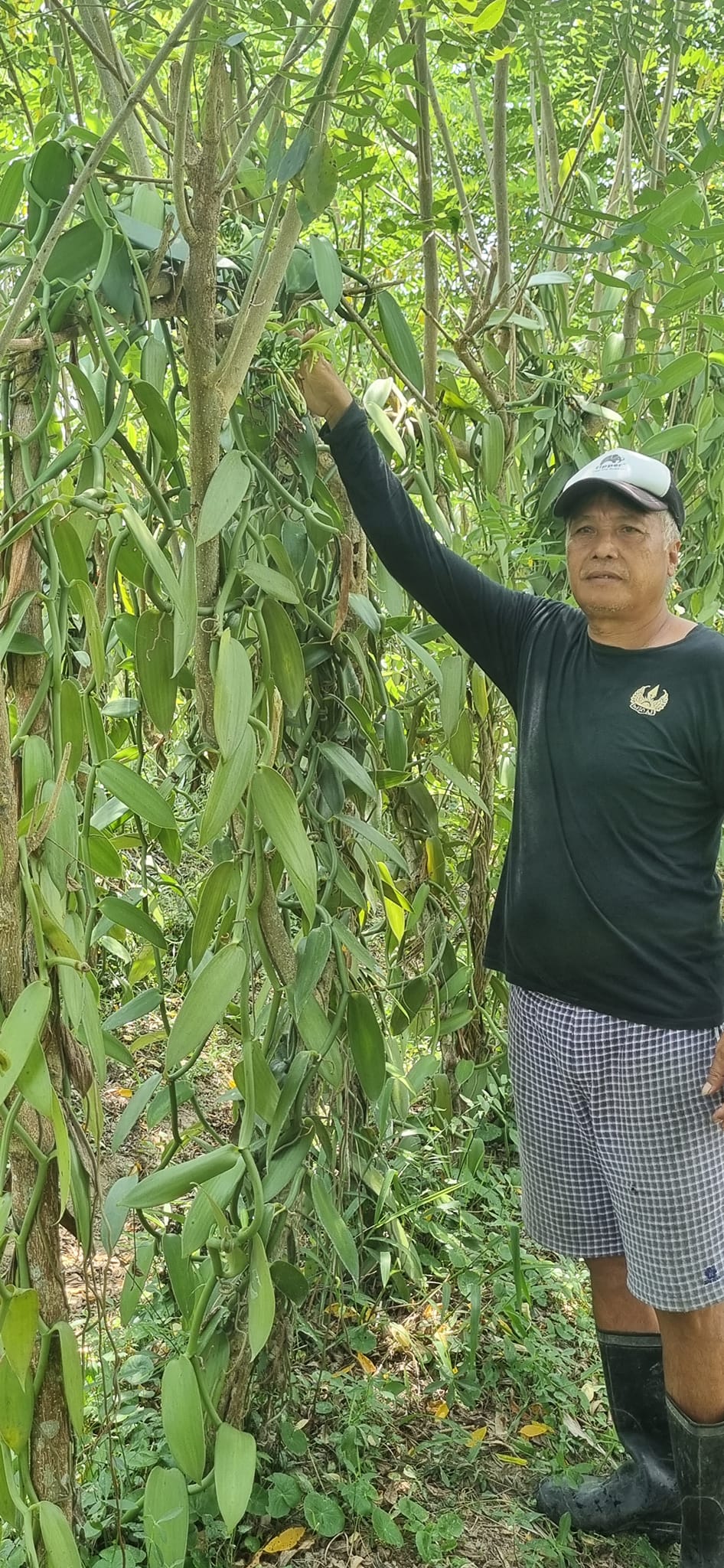
February has been one of those months that has slipped past unnoticed. The vanilla has grown, but without taking calipers to the fruit you wouldn’t know it! Still another three months at least to the beginning of the harvest.
The focus has been on improving our processing methods. What is becoming clear is that the key is absolutely the vanillin content. Normally, vanilla is dried swiftly for a couple of hours per day in the sun. When we slow this process down, just an hour per day for the second week and even less thereafter, we get fat vanilla beans that are sticky. I believe this stickiness indicates a high concentration of vanillin, from the slow drying. Of course, the unripe beans don’t reach this stage, making it imperative to process the very ripe beans and focus on them. We are testing massaging the bean as well, no result either way so far.
When the vanillin content of the bean gets high enough, it will not get mouldy. This is the stage we are seeking, for then it is ready to sell. It is noticeable that a bean will be fat and ripe at one end, and shrivelled at the stem. The stem can get mouldy. I think this is where the massaging comes into play, distributing the vanillin around the bean, getting it into the stem and protecting it.
Once we have the vanillin content up high enough to protect from mould, which we assist with regular sun exposure, we are packing the vanilla in polystyrene boxes and letting it mature. Polystyrene is a relatively benign hard foam – it can be eaten by morio mealworms for recycling. And it provides a very stable atmosphere for the vanilla to mature. And it does. We are seeking the next level – crystallization. This is when the vanillin content is above 3% and crystals of vanillin form on the outside of the beans. It is the holy grail of vanilla production, providing the most expensive, in-demand beans. A grade that seems to have been forgotten by the trade. You can find crystallised vanilla still in Madagascar and I saw some from Uganda recently. Not something I have encountered in Indonesia.
We have made some boxes from white teak, kiln dried. We have 1kg, half kg and 100g boxes. The hundred-gram boxes have a glass sliding lid which we intend to engrave. On order are boxes made from the lighter cempaka wood which will be carved with scenes of Balinese life – and mythology. We will also test stiff 3-ply cardboard boxes. All of these to be lined with wax paper in the time humoured method.
Although this is just experimentation, guests are taking one look at the 100g boxes and buying them. Paying US$50 a box without a quibble. That’s US$500 a kilo, at a time when extraction grade is going for US$50 a kilo.
Of course, there is a world of difference between selling retail boxes to guests, and shifting several hundred tons of vanilla for the same price. This is the very top grade, and we shall be focusing on selling it direct.
Currently, there is very little vanilla available to buy from farmers. What there is, needs a few more months to mature but sadly they are already harvesting and amazed when we refuse it. Slowly, slowly, we will get through to them how to harvest and process.
A top local chef came to visit the other day, and was blown away by our Amazonian butternuts. We have discovered we can harvest while hard, and they will still ripen off the tree. The chef wants as much as we can supply, so we shall be using the trees as vanilla support and are busy propagating them. He has may ideas on how to use them, let’s see if we can make them a staple.
Of course, the major investor has continued to be silent. His other investments have not happened either. We understand that he has not been able to raise the finance he expected. We have long disregarded his potential. As usual, there are many other investors circling, but this one did appear to be happening.
The February event was a washout, heavy rain and dreadful traffic meant very few attendees. We still acquired four good leads. We won’t do another event in deepest traffic jam country. Better in Ubud or Sanur, possibly even Nusa Dua.
February investment banked was Rp 139,554,683, giving us a total for the year of Rp 300,544,683 and to date of Rp 10,578,735,570.
Rex Sumner
Royal Spice Gardens is an Indonesian Foreign Investment Company, in Indonesia known as a Perusahaan Modal Asing (PMA).
NIB Licence number 0220100502286. NPWP: 94.830.504.0- 905.000.
PT Royal Spice Gardens Indonesia, Jl. Raya Pejeng, Tampaksiring, Gianyar, Bali 80552, Indonesia
Website by Simia Solutions / Cre8 Design Studio
Powered by Pak Kriss’s Compliance Framework.
Even in uncertain times, credible, stable & realistic opportunities are available for the astute investor.
Get the edge by obtaining clear, concise and rapid information. Fill out the form to receive our latest prospectus!